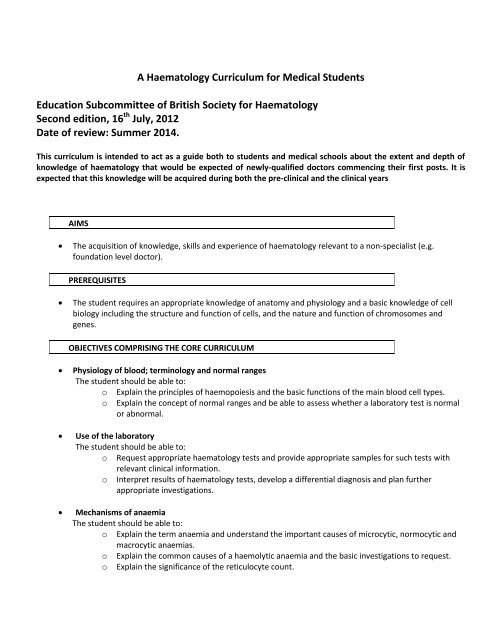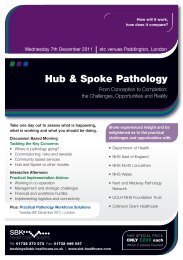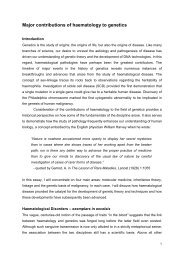A Haematology Curriculum for Medical Students Education ...
A Haematology Curriculum for Medical Students Education ...
A Haematology Curriculum for Medical Students Education ...
You also want an ePaper? Increase the reach of your titles
YUMPU automatically turns print PDFs into web optimized ePapers that Google loves.
A <strong>Haematology</strong> <strong>Curriculum</strong> <strong>for</strong> <strong>Medical</strong> <strong>Students</strong><br />
<strong>Education</strong> Subcommittee of British Society <strong>for</strong> <strong>Haematology</strong><br />
Second edition, 16 th July, 2012<br />
Date of review: Summer 2014.<br />
This curriculum is intended to act as a guide both to students and medical schools about the extent and depth of<br />
knowledge of haematology that would be expected of newly-qualified doctors commencing their first posts. It is<br />
expected that this knowledge will be acquired during both the pre-clinical and the clinical years<br />
<br />
AIMS<br />
<br />
The acquisition of knowledge, skills and experience of haematology relevant to a non-specialist (e.g.<br />
foundation level doctor).<br />
<br />
PREREQUISITES<br />
<br />
The student requires an appropriate knowledge of anatomy and physiology and a basic knowledge of cell<br />
biology including the structure and function of cells, and the nature and function of chromosomes and<br />
genes.<br />
<br />
OBJECTIVES COMPRISING THE CORE CURRICULUM<br />
<br />
<br />
<br />
Physiology of blood; terminology and normal ranges<br />
The student should be able to:<br />
o Explain the principles of haemopoiesis and the basic functions of the main blood cell types.<br />
o Explain the concept of normal ranges and be able to assess whether a laboratory test is normal<br />
or abnormal.<br />
Use of the laboratory<br />
The student should be able to:<br />
o Request appropriate haematology tests and provide appropriate samples <strong>for</strong> such tests with<br />
relevant clinical in<strong>for</strong>mation.<br />
o Interpret results of haematology tests, develop a differential diagnosis and plan further<br />
appropriate investigations.<br />
Mechanisms of anaemia<br />
The student should be able to:<br />
o Explain the term anaemia and understand the important causes of microcytic, normocytic and<br />
macrocytic anaemias.<br />
o Explain the common causes of a haemolytic anaemia and the basic investigations to request.<br />
o Explain the significance of the reticulocyte count.
Haematinic deficiency and the anaemia of chronic disease<br />
The student should be able to:<br />
o Describe the haematological investigations in patients with suspected haematinic deficiency<br />
(e.g. iron, vitamin B12 or folate deficiency), the common clinical features and the important<br />
underlying causes of these disorders.<br />
o Describe the role and complications associated with haematinic replacement treatment.<br />
o Describe the clinical and haematological features of the anaemia of chronic disease and explain<br />
how this is distinguished from iron deficiency.<br />
o Explain the common haematological abnormalities (e.g. anaemia, elevated erythrocyte<br />
sedimentation rate) that can occur in patients with non-haematological systemic diseases.<br />
Thalassaemias and haemoglobinopathies<br />
The student should be able to:<br />
o Explain the haematological abnormalities of patients with haemoglobinopathies (e.g. alpha and<br />
beta thalassaemia trait, thalassaemia major and sickle cell disease) and explain the important<br />
clinical features and complications of these disorders.<br />
o Explain the significance of sickle cell trait.<br />
Disorders of white cells<br />
The student should be able to:<br />
o Describe the common causes of leucocytosis and leucopenia.<br />
o Describe the common causes and clinical significance of neutropenia, neutrophilia,<br />
lymphocytosis and eosinophilia.<br />
Obstetric haematology<br />
The student should be able to:<br />
o Describe the changes that occur in haematological values in pregnancy.<br />
o Describe the role of maternal testing in predicting fetal haemoglobinopathies and thalassaemia.<br />
o Explain how Rh D alloimmunisation can be avoided.<br />
Paediatric haematology<br />
The student should be able to:<br />
o Explain how healthy neonates and children differ haematologically from adults.<br />
o Describe the common acquired and inherited causes of anaemia in childhood.<br />
o Describe the common causes of bruising and bleeding in both the neonatal period and<br />
childhood.<br />
Haemostasis overview<br />
The student should be able to:<br />
o Take a competent history from a patient with a history of thrombosis or abnormal bleeding or<br />
bruising and describe the common inherited and acquired causes of thrombosis and bleeding.<br />
o Explain the tests in a coagulation screen and their limitations.<br />
Thrombosis – venous and arterial<br />
The student should be able to:
o<br />
o<br />
o<br />
Explain the epidemiology, diagnosis and management of venous thromboembolism including<br />
primary and secondary prevention.<br />
Explain the inherited and acquired risk factors <strong>for</strong> venous thromboembolism.<br />
Discuss the risk factors <strong>for</strong> arterial thrombosis.<br />
<br />
<br />
<br />
<br />
<br />
Inherited Bleeding Disorders<br />
The student should be able to:<br />
o Explain the basic clinical and laboratory abnormalities of patients with inherited bleeding<br />
disorders (e.g. haemophilia and von Willebrand disease).<br />
Acquired Bleeding Disorders<br />
The student should be able to:<br />
o Describe the mode of action, monitoring blood tests and complications of the currently used<br />
anticoagulant and anti-platelet drugs.<br />
o Explain how to diagnose and manage patients with overdoses of anticoagulants who are<br />
bleeding as well as those who are not bleeding.<br />
o Describe the coagulopathy associated with liver disease, renal disease, massive blood loss and<br />
disseminated intravascular coagulation, and explain the basic principles of management of<br />
these conditions.<br />
Thrombocytopenia<br />
The student should be able to:<br />
o Describe the common causes of thrombocytopenia.<br />
o Describe the presenting symptoms, signs and blood count abnormalities of idiopathic<br />
(autoimmune) thrombocytopenic purpura (ITP).<br />
o Describe the presenting symptoms, signs and blood test abnormalities of thrombotic<br />
thrombocytopenic purpura (TTP) and recognise the need <strong>for</strong> urgent treatment.<br />
Blood groups and antibodies<br />
The student should be able to:<br />
o Describe the ABO and Rh D antigens and antibodies.<br />
o Explain the significance of allo-antibodies in relation to blood transfusion and haemolytic<br />
disease of the newborn.<br />
o Explain how to take and label blood samples and request blood components <strong>for</strong> transfusion and<br />
recognise the time scales to obtain blood components.<br />
o Explain what is meant by ‘G and S’ (group and screen), crossmatch (compatibility tests) and<br />
electronic issue.<br />
o Explain how blood products are safely stored and administered.<br />
o Explain how volunteer donors are recruited and screened.<br />
Safe and appropriate prescribing of blood components and products<br />
The student should be able to:<br />
o Discuss the indications <strong>for</strong> red cell transfusion.<br />
o Discuss the indications <strong>for</strong> platelet transfusion.<br />
o Discuss the indications <strong>for</strong> fresh frozen plasma (FFP), cryoprecipitate and prothrombin complex<br />
concentrate.<br />
o Recognise that some patients require special blood components (e.g. irradiated components).<br />
o Discuss the management of massive blood loss.
o<br />
Discuss alternatives to blood transfusion and the need to conserve the blood supply.<br />
<br />
<br />
<br />
<br />
<br />
<br />
<br />
Complications of blood product transfusion<br />
The student should be able to:<br />
o Discuss the complications of transfusion and their prevention, diagnosis and management<br />
• Immunological<br />
ABO mismatch<br />
Delayed haemolytic transfusion reactions<br />
Transfusion-related acute lung injury<br />
Anaphylaxis<br />
Non-haemolytic febrile transfusion reactions<br />
• Non-Immunological<br />
Fluid overload<br />
Transmission of infection.<br />
Lymphadenopathy<br />
The students should be able to discuss the common causes of lymphadenopathy.<br />
Hodgkin and non-Hodgkin lymphomas<br />
The student should be able to:<br />
o Describe the common clinical features and course of Hodgkin and non-Hodgkin lymphoma.<br />
Multiple myeloma and MGUS (Monoclonal Gammopathy of Uncertain Significance)<br />
The student should be able to:<br />
o Describe the basic haematological, biochemical, immunological and clinical features of multiple<br />
myeloma.<br />
o Distinguish between multiple myeloma, MGUS and benign polyclonal<br />
hypergammaglobulinaemia.<br />
o Outline the very basic pathological and clinical features of primary amyloidosis.<br />
Acute and chronic leukaemias<br />
The student should be able to:<br />
o Outline the natural history and presenting clinical and haematological features of acute<br />
leukaemias.<br />
o Explain how to recognise and treat neutropenic sepsis.<br />
o Describe the haematological and clinicopathological features of chronic lymphocytic leukaemia<br />
and chronic myeloid leukaemia.<br />
Myelodysplastic syndromes<br />
The student should be able to:<br />
o Outline the clinical and haematological features of the myelodysplastic syndromes.<br />
Myeloproliferative neoplasms (myeloproliferative disorders)<br />
The student should be able to:<br />
o Explain the differential diagnosis of a patient with a raised haemoglobin concentration and the<br />
clinical and laboratory features that help to distinguish polycythaemia vera from other causes of<br />
a high haemoglobin concentration.
o<br />
Explain the main laboratory and clinical features of essential thrombocythaemia and primary<br />
myelofibrosis.<br />
<strong>Medical</strong> Emergencies in <strong>Haematology</strong><br />
The student should be able to:<br />
o Recognise medical emergencies in haematology including neutropenic sepsis, spinal cord<br />
compression, superior vena cava obstruction, thrombotic thrombocytopenic purpura, recent<br />
onset of a bleeding disorder and hypercalcaemia.








